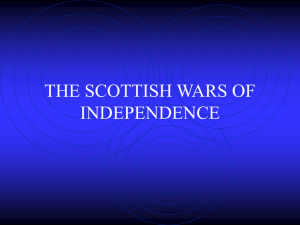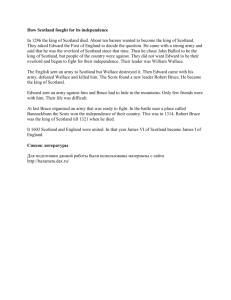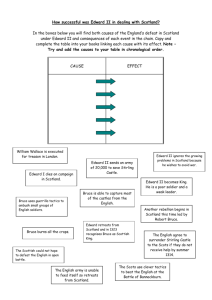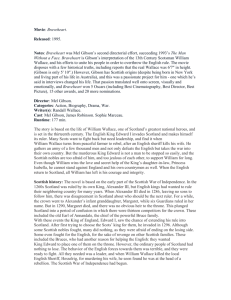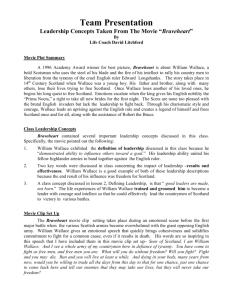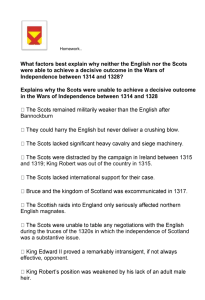William Wallace and Scottish resistance: events
advertisement
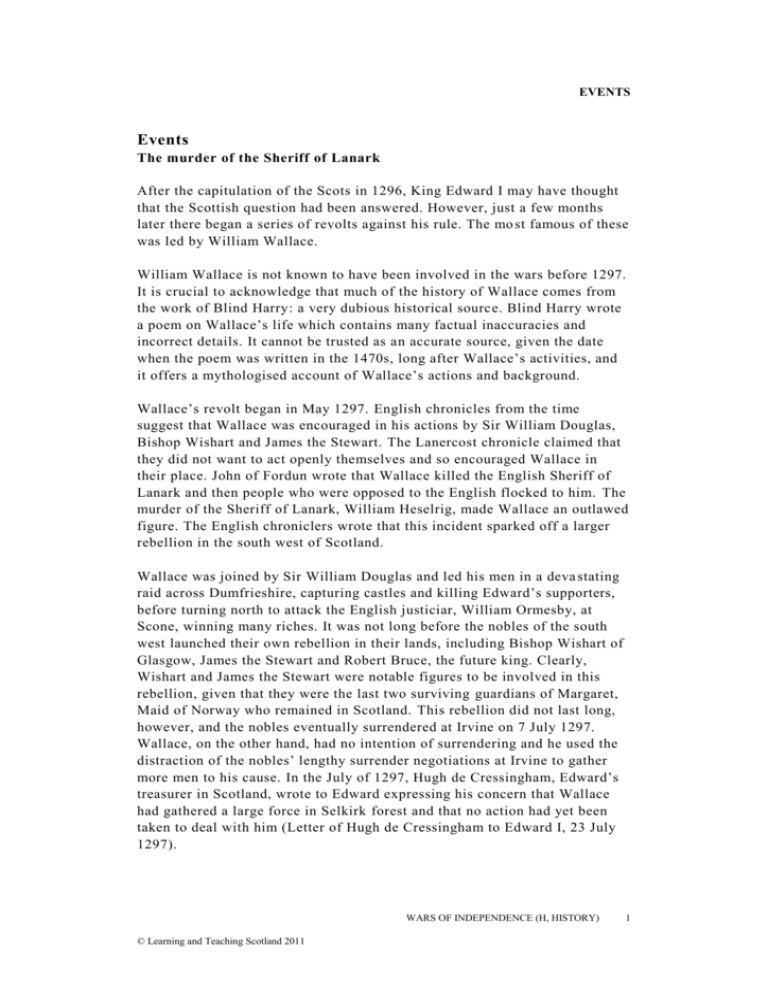
EVENTS Events The murder of the Sheriff of Lanark After the capitulation of the Scots in 1296, King Edward I may have thought that the Scottish question had been answered. However, just a few months later there began a series of revolts against his rule. The mo st famous of these was led by William Wallace. William Wallace is not known to have been involved in the wars before 1297. It is crucial to acknowledge that much of the history of Wallace comes from the work of Blind Harry: a very dubious historical source. Blind Harry wrote a poem on Wallace’s life which contains many factual inaccuracies and incorrect details. It cannot be trusted as an accurate source, given the date when the poem was written in the 1470s, long after Wallace’s activities, and it offers a mythologised account of Wallace’s actions and background. Wallace’s revolt began in May 1297. English chronicles from the time suggest that Wallace was encouraged in his actions by Sir William Douglas, Bishop Wishart and James the Stewart. The Lanercost chronicle claimed that they did not want to act openly themselves and so encouraged Wallace in their place. John of Fordun wrote that Wallace killed the English Sheriff of Lanark and then people who were opposed to the English flocked to him. The murder of the Sheriff of Lanark, William Heselrig, made Wallace an outlawed figure. The English chroniclers wrote that this incident sparked off a larger rebellion in the south west of Scotland. Wallace was joined by Sir William Douglas and led his men in a deva stating raid across Dumfrieshire, capturing castles and killing Edward’s supporters, before turning north to attack the English justiciar, William Ormesby, at Scone, winning many riches. It was not long before the nobles of the south west launched their own rebellion in their lands, including Bishop Wishart of Glasgow, James the Stewart and Robert Bruce, the future king. Clearly, Wishart and James the Stewart were notable figures to be involved in this rebellion, given that they were the last two surviving guardians of Margaret, Maid of Norway who remained in Scotland. This rebellion did not last long, however, and the nobles eventually surrendered at Irvine on 7 July 1297. Wallace, on the other hand, had no intention of surrendering and he used the distraction of the nobles’ lengthy surrender negotiations at Irvine to gather more men to his cause. In the July of 1297, Hugh de Cressingham, Edward’s treasurer in Scotland, wrote to Edward expressing his concern that Wallace had gathered a large force in Selkirk forest and that no action had yet been taken to deal with him (Letter of Hugh de Cressingham to Edward I, 23 July 1297). WARS OF INDEPENDENCE (H, HISTORY) © Learning and Teaching Scotland 2011 1 EVENTS The rebellion in the north While Wallace was terrorising the English garrisons in the south, a second significant rebellion had began in the north. Sir Andrew Murray had been fighting alongside his father at the Battle of Dunbar, and had been captured at the end and taken to England as a prisoner. However, he managed to escape and return to his father’s lands around Inverness, undiscov ered. There he found that many of the castles had English garrisons occupying them, including his father’s castle. Murray raised his family standard in his own lands, and soon found himself with a strong following. He was able to recapture many castles, including Inverness, Urquhart, Nairn and Banff. By July 1297 he had driven the English out of Scotland north of the Tay. By August he had moved south to threaten Angus and the towns of Dundee and Perth. It was there that he learned of Wallace’s rebellion and the two met for the first time. By now the news of the nobles’ surrender at Irvine had reached both men, and soon they would call themselves the Commanders of the Army of Scotland, vowing to carry on the fight in the name of King John. The Battle of Stirling Bridge, 11 September 1297 The English army was led by Edward’s Lieutenant of Scotland, Warenne, the Earl of Surrey and his aide, Hugh Cressingham, the Treasurer of Scotland. The Earl of Surrey had been responsible for the crushing defeat of the Scots at Dunbar. Hugh Cressingham was no military commander. In fact he had already sent some of the English soldiers home, in order to save paying their wages. Both men were supremely confident that they could defeat the Scots, and had no fear of Wallace or Murray. At sunrise on the morning of the battle, the English army began crossing the narrow Bridge of Stirling. It was only wide enough for a few men to cross at once. However, the Earl of Surrey had slept in and the men were ordered back across the bridge to await his arrival. When Surrey eventually woke he gave the order for the army to cross again, but when the Scottish Earl of Lennox arrived with messages from William Wallace he again recalled his men back across the river. In fact, the English could have crossed at the ford a few miles upstream. Both Surrey and Cressingham felt that this was unnecessary and instead decided to use the bridge to cross. Meanwhile, William Wallace and Andrew Murray had spent the entire morning on the top of the Abbey Craig watching the comings and goings of the English troops. Thus when they began to cross for a third time, the Scottish commanders were quite sure as to how the English forces were going to manoeuvre for the coming battle. When roughly one -third of the English 2 WARS OF INDEPENDENCE (H, HISTORY) © Learning and Teaching Scotland 2011 EVENTS troops had crossed they ordered their spearmen, walking close together in a formation called a schiltron, to charge the English. As the English continued crossing, the Scots charged. They quickly managed to cut them off from the rest of the English a rmy on the other side of the bridge. Unable to retreat, some of the English tried to swim the river, but they drowned. Most of the English on the Scots side of the river were wiped out, including Hugh Cressingham, a man who was so hated in Scotland that hi s body was reportedly skinned and parts of him made into souvenirs. The Earl of Surrey immediately ordered a retreat, and he led the rest of his surviving men back to Berwick. Wallace as Guardian of Scotland After the stunning victory at Stirling Bridge, Wallace and Murray were made joint Guardians of Scotland by the nobility. The nobility may have been using the commanders of Scotland’s army to fight for independence without putting themselves at risk, or perhaps were simply frightened of them and thei r army. Whatever the reason, Wallace and Murray were now effectively in control of the Scottish government. Murray’s actual involvement in the running of the kingdom must have been slight as he died weeks after the Battle of Stirling Bridge, presumably of the wounds that he suffered at the battle. However, we do know that this new administration was seen as legitimate. Wallace and Murray were ruling in the name of the absent king, John. Wallace continued the war with a devastating raid into northern Engla nd. Few documents survive that give us some insight into the personal rule of Wallace in 1297–8. The most important is a letter written in October 1297 and issued in the names of Murray and Wallace. It was sent to the merchants of Lubeck and Hamburg, informing them that Scotland was no longer under the dominance of England and was now open for business. This shows Wallace’s administration of the kingdom to be self-assured and confident of its position in the war. The Battle of Falkirk By July 1298, Edward was ready to march into Scotland again. Wallace had at first not intended to meet the English in battle, and indeed it would appear he outmanoeuvered Edward. Instead of fighting him he sent most of his men to attack Carlisle. However, by 22 July Edward had succeeded in confronting Wallace on the field of battle. WARS OF INDEPENDENCE (H, HISTORY) © Learning and Teaching Scotland 2011 3 EVENTS Wallace placed his men in three circular schiltro ns facing the enemy. His archers were positioned in between the schiltro ns to protect them from English archers, and his cavalry were on each flan k, to protect his archers from being swept away by an English charge. Wallace’s men, although outnumbered, held the defensive position: they were dug in and protected by stakes driven into the ground, and a boggy morass in front of them. So what went wrong? The English cavalry attacked from both flanks at the same time. The Scots cavalry were unable to stand against the superior numbers and fled. This has led to speculation that the cavalry may have been treacherous or , as Fiona Watson suggests, the nobles may have fled so quickly in order to be able to fight at a later date. The English knights then attacked the schiltro ns but were unable to penetrate the thick wall of Scots spears. However, the Scots archers didn’t have any protection and were quickly kil led or scattered. The English knights withdrew a little. With no archers of their own to counter the English longbowmen, the schiltrons were forced to weather a barrage of missile fire. As the numbers of dead and dying Scots increased, the English knights charged again. This time there were too many gaps in the spear wall and the Scots were crushed. Thousands of Scots died, but Wallace managed to flee north into the woods with most of his commanders. However, his reputation was damaged and Wallace resigned as Guardian of Scotland. Continuing Scottish resistance With the resignation of William Wallace after the Battle of Falkirk, Scottish resistance to Edward I continued under the guidance of the Guardians of Scotland. John Comyn and Robert Bruce assumed j oint leadership, although they had no particular love for each other. In 1299, a Scottish delegation successfully lobbied Pope Boniface VIII to take their side against Edward I and secure the release of King John to papal authority. Papal support was not consistent for the duration of the conflict, but pressure at this time came jointly from the Scots and their allies the French. There had been more or less permanent lobbying of the Pope since 1295 by the Scots. The Pope issued a papal bull condemning Edward’s conduct against the Scots. The Scots continued to have other successes during this period. The guardians were the de facto government, issuing orders in the name of King John. The Scots attacked English garrisons and burned fortifications. They took control of the north of Scotland and made the English occupiers feel under threat throughout the country. In 1299, Stirling Castle fell to the Scots, having been starved into submission. Wallace himself went to Europe to lobby on behalf 4 WARS OF INDEPENDENCE (H, HISTORY) © Learning and Teaching Scotland 2011 EVENTS of the Scottish cause. Edward I was largely pre-occupied with his affairs in France at this time. Robert Bruce was not so keen to see King John return to Scotland. John’s return would surely see the end of Robert’s hopes of acquiring the crown. He resigned his guardianship in 1300, switching sides to join Edward in 1302. The reason for this may be that John Balliol had been released to French custody and there was hope amongst the Scots that a restoration may be possible, and that Balliol could travel to Scotland with a Fr ench army. Edward’s military campaigns against the Scots continued in 1300, when he captured Caerlaverock Castle, using a powerful siege engine. This castle was well defended and Edward himself attended the siege because it would not surrender. Edward then defeated a small Scottish army on the River Cree. He followed this up with further raids in 1301 and 1302. However, John Comyn and the new guardian, John Soules, refused to give battle to the English king, retiring the army north, until the English were forced to retreat for the winter. The only pitched battle in 1303 was actually a victory for Comyn. The Battle of Roslin (May 1303) saw an English force wiped out during a night raid. The guardians continued to resist as best as they could, joined again by William Wallace. By 1303, however, the Scots position had worsened considerably. The French and English agreed a treaty in May 1303 which excluded the Scots, following Philip’s defeat in 1302. This meant the loss of the crucial support of the French king. The Scots also lost the support of the Pope, who wrote blaming the Scottish bishops for the continuing the war in August 1302. This was as a result of a quarrel between the Pope and King Philip of France, which led the Pope to favour Edward. Edward was now free to concentrate fully on the Scots. Edward’s final invasion in 1303–04 saw the English forces cross the Forth for the first time and take the war into the heart of the Comyn lands. Edward wintered in Fife, to maintain the pressure on the Scots. The garrison of Stirling finally surrendered in July 1304, after a three -month siege. By then Comyn and the other leaders, apart from Wallace and Soules, had already faced the inevitable and accepted terms from Edward. With the failure of the French initiative it appeared now that King John would not return. Comyn surrendered in February 1304, along with the council. Edward promised to respect the laws and customs of Scotland. Edward restored lands to those who surrendered and gave Scots positions in the government. The main change was that Scotland was no longer to be a kingdom, but was pointedly referred to as the land of Scotland. WARS OF INDEPENDENCE (H, HISTORY) © Learning and Teaching Scotland 2011 5 EVENTS William Wallace was singled out. He was not included in the peace terms, and he was not allowed to surrender. He went on the run, continuing the fight against the English, but was eventually betrayed by Sir John Menteith in 1305. 6 WARS OF INDEPENDENCE (H, HISTORY) © Learning and Teaching Scotland 2011
